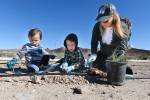OUTDOOR BRIEFS
FREE LESSONS
Beginner's fishing clinic scheduled
The Nevada Department of Wildlife will be having a free fishing clinic for people of all ages starting at 9 a.m. July 12 at Floyd Lamb Park located off of Durango Drive and U.S. 95. Participants will learn casting skills, fish identification, how to choose baits and lures and the basics of knot tying. The clinic will conclude with participants putting their newly learned fishing skills to the test.
Those who 12 years old and over must have a Nevada fishing license. For more information and registration, contact Ivy Santee at (702) 486-5127, ext. 3503.
BIG GAME STATUS
Hunters can start scouting with report
Now that results of the 2008 big game tag draw have been released, it's time for Nevada hunters to do their homework so they are ready when opening day arrives. Traditionally, this homework assignment has meant spending as much time in the field as possible before opening day. However, with gasoline prices reaching record highs every day, time spent afield may be a luxury many hunters can no longer afford.
But that doesn't mean they are out of luck. Each year the Nevada Department of Wildlife publishes its Big Game Status Report, a report that contains information on game animal populations around the state and is based on surveys conducted by area biologists. It is a means of scouting from home.
"This report is a terrific resource for hunters. It contains lots of information, harvest statistics and even historical information. This is more than a mere snapshot in time and provides hunters with the bigger picture of what's been happening in their hunt area," said Martin Olson, southern region hunter education coordinator for NDOW.
Information in the status report is broken down first by species and then by herd management unit. A hunter with a tag for Area 10, which comprises of units 101-108, can read through the report and learn that Area 10 contains nearly 25 percent of Nevada's mule deer population. Results from the 2007 post-season deer survey documented a buck-to-doe ratio of 30 bucks for each 100 does.
A quick check of the harvest data shows that during the 2007 rifle season 42 percent of the hunters were successful during the early season. In the late season, that number was 65 percent and 42 percent of the deer harvested were four-point or larger bucks. "These figures should give hunters with Area 10 tags an idea of what they can expect if they are willing to put in the work," said Olson, who hunts the area whenever he can. "If they couple this data with that found in our hunter information sheets, hunters will learn some things that will ultimately benefit them when they get in the field."
In addition to reading the Big Game Status Report and hunter information sheets, hunters can call NDOW biologists if they desire more information. The key to making the most of their time and that of the biologists is being prepared before they make the phone call, said Steve Kimble, supervising game biologist.
"Hunters should read both the Big Game Status Report and hunter information sheets are available online at www.ndow.org.
'YEAR OF THE FROG'
Many amphibians found in the desert
In case you missed it, 2008 is a leap year -- the perfect criterion for making it the "Year of the Frog." And that's just what wildlife conservationists from around the world have done in creating a coordinated public awareness campaign to inform people around the globe about the plight of amphibians.
Amphibians are especially vulnerable to changes in their environment because their skin is highly permeable.
The same is true for life in the Nevada desert. Frogs are not the type of animal you would expect to see in a desert environment, but they're here, along with a number of toads. How do you tell the difference between frogs and toads? The Audubon Society makes it easy with these descriptions: Frogs are water dwellers with long legs and slimy skin, and toads are short, squat, land dwellers with dry, warty skin.
Some of the frogs and toads that can be seen in Southern Nevada include the Pacific Tree frog or Chorus Frog, Great Basin Spadefoot toad, Woodhouse's toad, Relict Leopard frog, Amargosa toad, Columbia Spotted frog, Southwestern toad, Red-spotted toad and the Great Plains toad. Those who would like to know what these critters look like will find an identification guide on the Nevada Department of Wildlife Web site.
Brian Hobbs, a native fish and amphibian biologist for NDOW, recently completed surveys for Amargosa toads near the town of Beatty about 120 miles north of Las Vegas. This toad only occurs in the Oasis Valley along a 10-mile stretch of the Amargosa River and some adjacent upland springs. Hobbs was joined by other biologists and even a few volunteers. While Hobbs and company had trouble with the toads not coming out on cool and windy nights, their counts were successful nonetheless. Hobbs said, the population is holding steady, even doing slightly better than it was 10 years ago.























